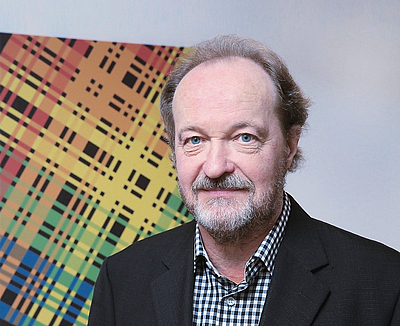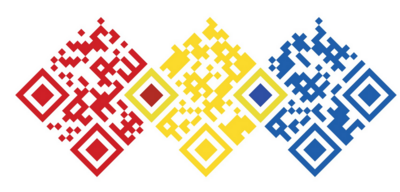Welcome at the Interface Culture program website.
Acting as creative artists and researchers, students learn how to advance the state of the art of current interface technologies and applications. Through interdisciplinary research and team work, they also develop new aspects of interface design including its cultural and social applications. The themes elaborated under the Master's programme in relation to interactive technologies include Interactive Environments, Interactive Art, Ubiquitous Computing, game design, VR and MR environments, Sound Art, Media Art, Web-Art, Software Art, HCI research and interaction design.

The Interface Culture program at the Linz University of Arts Department of Media was founded in 2004 by Christa Sommerer and Laurent Mignonneau. The program teaches students of human-machine interaction to develop innovative interfaces that harness new interface technologies at the confluence of art, research, application and design, and to investigate the cultural and social possibilities of implementing them.
The term "interface" is omnipresent nowadays. Basically, it describes an intersection or linkage between different computer systems that makes use of hardware components and software programs to enable the exchange and transmission of digital information via communications protocols.
However, an interface also describes the hook-up between human and machine, whereby the human qua user undertakes interaction as a means of operating and influencing the software and hardware components of a digital system. An interface thus enables human beings to communicate with digital technologies as well as to generate, receive and exchange data. Examples of interfaces in very widespread use are the mouse-keyboard interface and graphical user interfaces (i.e. desktop metaphors). In recent years, though, we have witnessed rapid developments in the direction of more intuitive and more seamless interface designs; the fields of research that have emerged include ubiquitous computing, intelligent environments, tangible user interfaces, auditory interfaces, VR-based and MR-based interaction, multi-modal interaction (camera-based interaction, voice-driven interaction, gesture-based interaction), robotic interfaces, natural interfaces and artistic and metaphoric interfaces.
Artists in the field of interactive art have been conducting research on human-machine interaction for a number of years now. By means of artistic, intuitive, conceptual, social and critical forms of interaction design, they have shown how digital processes can become essential elements of the artistic process.
Ars Electronica and in particular the Prix Ars Electronica's Interactive Art category launched in 1991 has had a powerful impact on this dialog and played an active role in promoting ongoing development in this field of research.
The Interface Cultures program is based upon this know-how. It is an artistic-scientific course of study to give budding media artists and media theoreticians solid training in creative and innovative interface design. Artistic design in these areas includes interactive art, netart, software art, robotic art, soundart, noiseart, games & storytelling and mobile art, as well as new hybrid fields like genetic art, bioart, spaceart and nanoart.
It is precisely this combination of technical know-how, interdisciplinary research and a creative artistic-scientific approach to a task that makes it possible to develop new, creative interfaces that engender progressive and innovative artistic-creative applications for media art, media design, media research and communication.
Josef Linschinger | Wortbilder – Bildworte
Eröffnung: 12. Juli 2025, um 14.00 Uhr; zu sehen bis 29. Oktober 2025 Schrift- und Heimatmuseum Bartlhaus, Museumstraße 16, Pettenbach
In diesem Sommer feiert der renommierte österreichische Vertreter der Konkreten Kunst, Josef Linschinger, seinen 80. Geburtstag u.a. mit einer Ausstellung von ausgewählten Werken im Bartlhaus.
Linschinger studierte an der Hochschule für Gestaltung in Linz, der heutigen Kunstuniversität, wo er später über 25 Jahre als Dozent und Professor lehrte. Neben der Lehre und seinem künstlerischen Schaffen organisierte er zwanzigmal die Symposien für Konkrete Kunst in Gmunden, die sich als wichtige Vernetzungsplattform im Bereich der Konkreten Kunst sowie Poesie etablierten und in deren Rahmen Werke von 600 internationalen Künstler:innen gezeigt wurden. Außerdem ist Linschinger Mitglied der Linzer Künstlervereinigung MAERZ und war langjähriger Präsident der Künstlergilde Salzkammergut. Er kann auf zirka 60 Einzelausstellungen und mehr als 500 Ausstellungsbeteiligungen in unterschiedlichen Ländern zurückblicken. Sein Werk wurde mit zahlreichen Preisen und Auszeichnungen gewürdigt, darunter die Kulturmedaille des Landes Oberösterreich und der Oberösterreichische Landeskulturpreis für Bildende Kunst.
Der Begriff Konkrete Kunst bezeichnet eine ungegenständliche Richtung, die auf mathematischen Grundlagen beruht und durch geometrische Konstruktion erzeugt wird. Die Werke sind keine Abstraktionen der Natur, sondern stehen für sich selbst. Sie führen Formen, Farben und Materialien nach vorab festgelegten Regeln, in reduzierter, ausgewogener Gestaltung zusammen. Dasselbe gilt für die Konkrete Poesie, bei der die Sprache nicht mehr der Beschreibung dient, sondern ihre optische Gestalt selbst zum poetischen Gegenstand wird.
Linschinger beschäftigt sich in seinen Werken mit der bildlichen Umsetzung sprachlicher Zeichen und benutzt dazu seit den 1990er Jahren unterschiedliche Schriftsysteme und Codes, wie zum Beispiel den in der Warenwelt allgegenwärtigen Barcode. Obwohl er optisch vertraut ist, bleibt er sehr schwer lesbar und wird deshalb zum visuellen Ausdruck von Form und Rhythmus. Der Künstler entwickelte ihn künstlerisch weiter, indem er die Konsonanten im klassischen Schwarzweiß wiedergibt und die Vokale ihrem Klang entsprechend farbig gestaltet.
Durch die Übersetzung in Codes werden Worte zu reiner Form. Linschinger verknüpft Schrift und Bild, wobei er den Fokus auf die sinnlich ästhetischen Qualitäten legt. Alle Gestaltungen sind bis ins kleinste Detail durchdacht und überlassen nichts dem Zufall. Sie laden dazu ein, sie zu entschlüsseln und das System dahinter zu entdecken.

